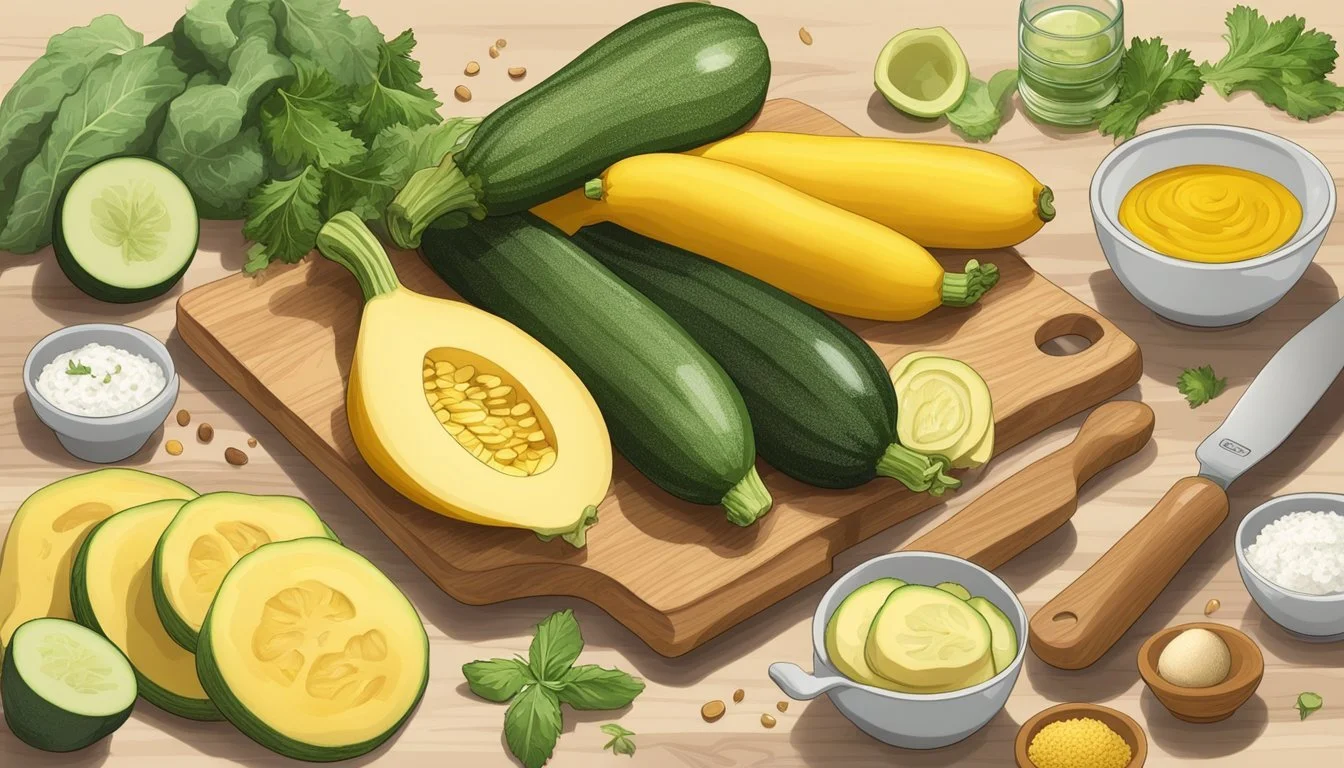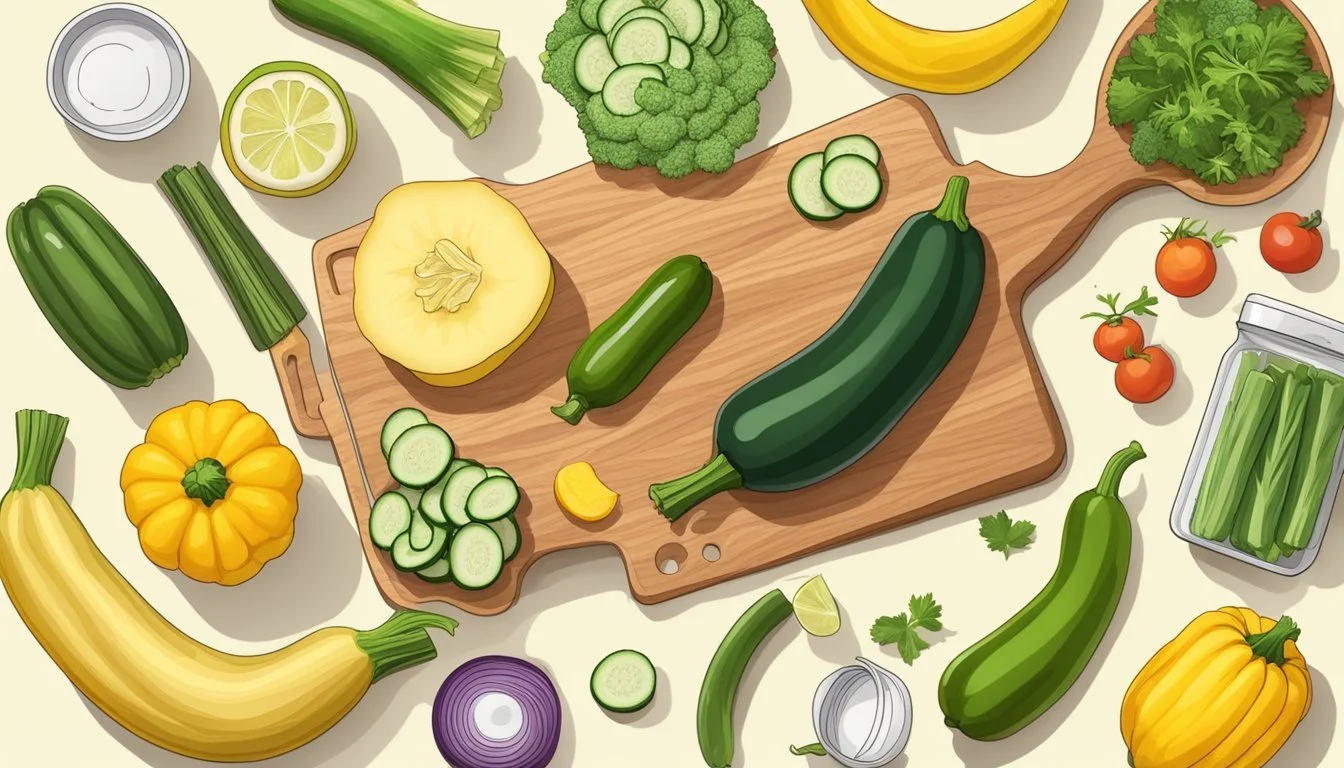How to Substitute Yellow Squash for Zucchini
A Simple Guide for Recipe Adaptations
When cooking, the versatility of ingredients is a boon for the adventurous home chef or anyone needing a quick substitution. Yellow squash and zucchini (What wine goes well with zucchini?) are often interchangeable in recipes due to their similar texture and flavor profiles. While zucchini is the more widely used of the two, with its distinct green color making it a staple in dishes like zucchini bread, ratatouille (What wine goes well with ratatouille?), and as a pasta substitute, yellow squash offers a slightly sweeter taste and can provide a colorful twist to traditional recipes.
Substituting yellow squash for zucchini is straightforward. Cooks should take into account that yellow squash, depending on the variety, may have a firmer texture and contain more seeds. This difference in seed quantity could slightly affect the moisture content and texture of the dish. For optimal results, yellow squash should be prepared in a manner similar to zucchini, such as shredding or dicing it into small, consistent pieces to ensure even cooking and integration into the final dish.
The process of substituting yellow squash for zucchini is especially practical when preparing casseroles, bread, soups, and stews. Since both vegetables typically require cooking, any marginal differences in cooking times are usually adjusted effortlessly during the overall cooking process. Moreover, the subtle flavor variations can enhance a dish, offering a refreshing take on a familiar recipe.
Understanding Yellow Squash and Zucchini
Yellow squash and zucchini are both varieties of summer squash. They are versatile vegetables, rich in vitamins and other nutrients, and are often used interchangeably in recipes.
Yellow Squash:
Color: Bright yellow, sometimes with white stripes.
Shape: Wider body with a bulbous end, often larger seeds.
Texture: Slightly firmer than zucchini.
Nutritional Benefits: Low in calories, contains vitamin C, vitamin A, fiber, and antioxidants.
Zucchini:
Color: Usually deep green, though there are golden varieties.
Shape: Consistently cylindrical and straight.
Texture: Tends to be slightly softer than yellow squash.
Nutritional Benefits: Low in carbs, high in potassium, vitamins, and fiber.
Both vegetables are fruits from a botanical standpoint but are treated as culinary vegetables. They share a similar flavor profile, mild with a hint of vegetable sweetness, which allows them to complement a range of ingredients such as tomatoes, eggplants (What wine goes well with eggplant?), and sweet potatoes (What wine goes well with sweet potatoes?). When prepared, they can take on the taste and seasonings of the dish they are in.
Due to their similar texture and moisture content, they can both be grilled, sautéed, roasted, or used in stews and casseroles. The main difference in their preparation is that yellow squash, especially larger ones with more seeds, may require longer cooking times.
Other summer squash varieties like crookneck, pattypan, and chayote can also be substituted, albeit with slight variations in flavor and texture.
Culinary Uses of Yellow Squash and Zucchini
Yellow squash and zucchini share similarities in texture and moisture content, making them largely interchangeable in recipes. They are both low in calories and rich in vitamins and minerals, enhancing dishes with not just flavor but also nutritional value.
Raw Applications
Yellow squash and zucchini can be thinly sliced or shredded to add a fresh, crisp element to salads or sandwiches. When used raw, they maintain their unique flavors and firm textures, providing a refreshing contrast to other vegetables. Both vegetables are excellent for making ribbon salads and add a colorful twist to traditional raw vegetable mixes.
Cooking and Baking
When cooked, yellow squash and zucchini become tender, making them a versatile component in a variety of dishes. They can be sautéed, grilled, roasted, or cooked in methods like stir-frying. For baking, zucchini is a popular ingredient in moist bread recipes and muffins, where it is often grated. Yellow squash can be used similarly in baked goods, bringing in moisture without an overpowering taste.
Cooking methods: Sauté, Grill, Roast
Baking applications: Bread recipe, Muffins
Specific Recipe Adaptations
In recipes such as casseroles, ratatouille, soups, and stews, yellow squash can substitute zucchini in equal amounts. It's advisable to remove excess seeds from larger yellow squashes to avoid changing the texture of the dish. For baked dishes like zucchini lasagna, squash can be thinly sliced as a direct swap and will perform similarly when layered with other ingredients such as pasta, eggplant (What wine goes well with eggplant?), and carrots.
Casserole: Same quantity, deseed if large
Baked dish: Slice thin, replace equally
Substituting Yellow Squash for Zucchini
When cooking and baking, one can confidently use yellow squash as a zucchini substitute, as they are versatile and often interchangeable in recipes. Each has a unique flavor while maintaining the ability to blend seamlessly into a variety of dishes.
Flavor and Texture Considerations
Yellow squash and zucchini share a mild flavor that makes them both suitable for a wide range of dishes. However, yellow squash tends to have a slightly more buttery taste and can be a bit firmer in texture. When replacing zucchini with yellow squash, it's essential to be aware that the squash may require a longer cooking time to achieve a texture similar to that of zucchini.
Nutritional and Dietary Benefits
Using yellow squash as a substitute not only maintains the versatility of the dish but also offers several health benefits. Both vegetables are low in calories and rich in essential nutrients, including vitamins and minerals like beta-carotene, manganese, magnesium, folate, and calcium. They contain comparable amounts of dietary fiber and antioxidants, making them an ideal choice for those following a vegan diet or seeking to boost their vegetable intake.
Adjustments in Cooking and Preparation
To successfully integrate yellow squash in place of zucchini, one might need to make slight adjustments:
Moisture Content: Yellow squash can contain slightly less moisture than zucchini. Depending on the recipe, adding a bit more liquid may be necessary to achieve the desired consistency.
Cooking Time: Since yellow squash can be firmer, increase the cooking time slightly.
Seasoning: Both vegetables absorb seasonings well, so continue to season as you would with zucchini.
By considering these elements, substituting yellow squash for zucchini can be done with ease, maintaining the integrity and flavor profile of the original dish.
Preservation and Storage Tips
When substituting yellow squash for zucchini, remember to consider the preservation and storage techniques to maintain their freshness. Both vegetables, being summer squash with high water content, can be stored in the refrigerator for one to two weeks when kept dry and held in a plastic bag in the crisper drawer.
For more extended storage, freezing is the most effective method. To prepare yellow squash and zucchini for freezing:
Wash and cut the ends off.
Slice or chop the squash into your desired shape.
Optionally, blanch the pieces in boiling water for 30 seconds to preserve texture and shape.
Step Action 1 Wash thoroughly 2 Cut as desired 3 Blanch (optional) 4 Dry thoroughly
After cutting and optional blanching, dry the squash thoroughly to remove excess moisture. This is crucial as it helps to prevent ice crystal formation and reduces tissue breakdown, maintaining the integrity of the squash when thawed.
For freezing:
Arrange the prepared squash in a single layer on a baking sheet.
Place the sheet in the freezer until the pieces are frozen solid.
Transfer the frozen squash into airtight bags or containers.
When properly stored, the squash will retain quality for several months in the freezer. Always label the storage bags or containers with the date of freezing to ensure the squash is used while at its best quality.
Exploring Other Vegetable Substitutes
When a recipe calls for zucchini and it's not available, many other vegetables can serve as apt substitutes, offering both similar textures and flavors.
Eggplant: A common substitute, eggplants boast a comparable texture, making them excellent for dishes like lasagna, where they retain shape and texture well.
Sweet Potato: With a denser texture, sweet potatoes add a sweet, robust flavor, suitable for baked and casseroles.
Chayote Squash: Chayote has a mild flavor and can mimic zucchini's texture in cooked dishes.
Patty Pan: Another summer squash, patty pan provides a texture and flavor profile similar to that of zucchini.
Crookneck Squash: Resembling yellow squash, crookneck can replace zucchini in most dishes.
Here's a quick guide to some zucchini substitutes:
Vegetable Best Used In Preparation Notes Eggplant Lasagna, stir-fry Slice thin to mimic zucchini layers Sweet Potato Bakes, soups Cube or slice depending on the dish Chayote Squash Stir-fry, salads Dice or slice; cook until tender Patty Pan Grilling, stuffing Use just like zucchini Crookneck Squash Soups, sautés Prepare as you would zucchini
While cucumbers, carrots, and tomatoes can be substituted in raw recipes where a crunchy texture is needed, they may not hold up as well during cooking. Pumpkin is another viable substitute if a more robust, hearty flavor is desired.
Careful consideration of these alternatives can seamlessly adapt recipes without sacrificing flavor or texture.




